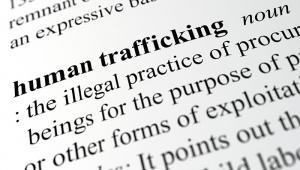
“From nail bars and car washes to sheds and rundown caravans, people are enduring experiences that are simply horrifying in their inhumanity.” These words from Theresa May in her time as home secretary explained the rationale behind the Modern Slavery Act 2015.
Just four years on, the act has shed light on these easily missed atrocities, with abuse now being uncovered at an exponential rate.
Under the act, public sector bodies have a legal duty to notify the Home Office of any suspected victim of modern slavery they come across. The victim is then dealt with via the National Referral Mechanism, which is run by Home Office subsidiary the National Crime Agency.
Recent figures from the NCA expose a hidden crisis of forced labour, sexual exploitation and domestic servitude running deep into the roots of UK communities. NCA statistics from March show the number of potential victims being reported rising by 80% since 2016.
The total number of reported cases has leapt from 916 in 2012 – when the NCA began recording data on victims – to 6,993 in 2018. These referrals can be made by any group that is a ‘first responder’ with a legal duty to refer victims, including councils, charities, police and the Home Office itself.
Analysis from the Local Government Association has found that the number of cases reported by local authorities alone has exploded in recent years, with referrals jumping from 153 in 2013 to 1,342 in 2018. There was a 66% (789) increase in referrals from 2017 to 2018 alone, from councils in England and Wales.
Besides the obvious moral requirement to tackle the problem, the financial implications for the UK are not insignificant. The Home Office said the cost of modern slavery to the UK economy was anywhere between £3.3bn to £4.3bn in 2016-17, owing to pressures on health services, victim services and law enforcement costs. Meanwhile, total government spending on fighting modern slavery adds up to just £61m in 2018-19.
"We found that most local authorities had no idea about the Modern Slavery Act at all. And most social workers had never heard of the National Referral Mechanism or that they had a duty to use it." – Tamara Barnett, project leader at the Human Trafficking Foundation
The latest NCA data shows that the total number of cases reported rose by 1,851 in just one year from 2017 to 2018. But Home Office estimates from 2014 – before the act came into effect – suggested there were already between 10,000 and 13,000 victims. The disparity in reported versus estimated numbers of victims suggests that the UK has only just begun to scratch the surface.
Under the Modern Slavery Act 2015, victims will receive help in the form of housing, counselling and financial support from the Home Office. This support ends 45 days after a victim is officially identified – a source of ongoing contention for campaigners, who argue it should be extended.
However, to receive this support, first responders must refer potential victims – yet the guidance is unclear.
The Human Trafficking Foundation charity works with groups responsible for tackling modern slavery, and is concerned about a lack of awareness of the act among public sector bodies.
“We found that most local authorities, for example, had no idea about the Modern Slavery Act at all. And most social workers had never heard of the National Referral Mechanism or that they had a duty to use it,” Tamara Barnett, project leader at the foundation, tells PF.
Barnett notes that the problems with the Modern Slavery Act lie in its inception. Specifically, she laments the fact that the act was drawn up primarily by the Home Office and the home secretary, with little or no input from what was then the Department for Communities and Local Government.
“DCLG was not really involved in all that work, so although the final act gave a clear direct statutory role for local authorities to be a first responder – the same role as police – they had no funding to support efforts, unlike the police,” she explains.
Nusrat Uddin, a solicitor specialising in public law and human rights, also notes confusion around expectations of what local government workers should be doing.
“The problem is that lots of local authorities don’t really know where their responsibilities start and end,” she tells PF.

Uddin, who works for Wilsons LLP, adds: “There’s absolutely no guidance and no funding for social services and social workers. They are first responders, meaning they have a legal duty to refer victims, so they need to be really well trained.
“But that is not happening in practice, and, even when we have clients that we identify as victims, when we refer them to the local authorities there’s a real lack of understanding as to what they can do.”
Both Uddin and Barnett raise the issue of “retrafficking” – where an individual comes out from being in the care of the Home Office’s NRM but falls back into a situation of exploitation, often because of a lack of support from their local authority.
Barnett points to a legal challenge against Bristol City Council in 2015 by a victim of modern slavery, who, after coming out of the NRM, asked the council for help as she considered herself to still be at risk. After refusing to provide the claimant with accommodation and financial support, the victim was forced back into engaging in prostitution as a means of providing her basic needs.
Bristol City Council later accepted that it was its responsibility to safeguard the individual and by failing to do so had breached the European Convention on Human Rights.
Uddin tells PF that people coming out of the NRM are particularly vulnerable to retrafficking. She recalls a client who has been retrafficked several times. On more than one occasion, the victim had been promised a job in a nail bar but was later forced into working on a cannabis farm.
This victim was also refused safeguarding by the local authority on the grounds of being an adult with the capacity to make their own decisions. Had this victim been a child, then the council would have had to provide safeguarding services under the Children Act 2004.
“Just because an adult has capacity does not mean that they are not going to be vulnerable to exploitation,” Uddin tells PF.
Training social workers to be able to identify potential victims is crucial, she adds, but doing so is difficult when you consider the funding constraints.
“If social workers are not funded and don’t have the resources [or] the time to scratch further, then the problem will get worse,” she says.
Another client, Uddin recalls, was retrafficked, despite being in contact with a social worker the entire time. The victim became embroiled in the county lines scandal, which sees people – often children – exploited and used to traffic drugs to rural areas.
Barnett tells PF that austerity and cuts to local government budgets have been damaging to the fight against slavery and human trafficking.
“Austerity has meant budgets are really tight, and there’s not enough funding around housing and safeguarding for adults. As a result, vulnerable adults don’t seem to be getting the basics – it’s extraordinary,” Uddin claims.
“It’s not that people working in the council are inhumane, it’s just that their budgets are extremely tight. If a case does not fit under the exact statutory duty, they are not going to do it.”
"The question is: how far do you go into the supply chain, and do you have enough resources to carry out investigations? I just don’t think councils will have the time or the money to do so." – Mohamed Hans, CIPFA procurement adviser
It’s perhaps easy to imagine traffickers as clandestine figures operating through organised crime networks, but there is concern that councils themselves come into contact with exploitative practices.
“It is more prevalent than people thought it was.” That is the stark assessment from CIPFA’s procurement adviser, Mohamed Hans, on the existence of modern slavery in local government supply chains.
Hans notes that where services are outsourced to third parties, there’s a greater chance of councils using parties that may exploit victims of modern slavery.
“The sector spends around £48bn on procurement every year, and there are now many more international supply chains, so there’s a good chance that some exploitation exists,” he tells PF.
Hans suggests that, until this point, looking out for exploitation has been a “box-ticking exercise” for many authorities. But now there needs to be a “more practical implementation of strategy”, he says.
He agrees with Uddin that training is vital to helping authorities identify victims. “Councils should get more training to spot the signs of exploitation, but it needs to be the right kind – a 30-minute session will not do,” he warns.
However, efforts to vet suppliers and train social workers are hampered by a lack of resources.
“The question is: how far do you go into the supply chain, and do you have enough resources to carry out investigations? I just don’t think councils will have the time or the money to do so,” Hans concludes.
Alan Rhodes, the Local Government Association’s modern slavery spokesman, tells PF: “We don’t have statutory duties to ensure that supply chains are free from modern slavery, and public sector bodies as a whole are not currently subject to the Modern Slavery Act’s requirements on transparency in supply chains – these only apply to businesses with a turnover of £36m or more.”
The act stipulates that a “commercial organisation” with a turnover of more than £36m must supply a statement each year setting out what steps it has taken to ensure that modern slavery is not taking place in its business.
Rhodes suggests that some authorities are determined to tackle the blight of modern slavery, but agrees that funding is an issue.
“There’s no specific funding provided to local authorities to support victims of modern slavery, so it is yet another responsibility that councils are picking up – one that they are not necessarily recognised by government for doing in terms of funding,” he says.
Commentators suggest that one area that must be addressed is the notion that modern slavery is a problem that is limited to urban areas and big cities, in particular.
“One of the issues is that modern slavery and trafficking has been regarded as an inner-city problem, but it’s affecting all of our communities and it’s happening in plain sight,” Rhodes asserts.
As Labour leader of the opposition at Nottinghamshire County Council, he says that awareness of the problem in rural communities is improving, citing the county lines scandal as a major factor. Being widely reported in the UK media has made the problem more visible both to councils and to the public, Rhodes adds.
"Trafficking victims might look like illegal immigrants, but they are often brought here against their will and, unless we scratch under the surface, we are not going to get anywhere." – Nusrat Uddin, solicitor
Barnett agrees: “People used to imagine it was very much a central London problem, but the data is increasingly showing that there is a lot elsewhere. I think people are getting better at realising.
“As part of our work, we have been getting councils, particularly on the outskirts of London, to realise they’ve got exactly the same problem as everyone else.”
Barnett explains that trafficking and slavery can take many forms and creep into various industries, like agriculture, labouring, restaurants and car washes.
Uddin says one of the barriers to eradicating the scourge of modern slavery is the stigma attached to victims. She notes that victims can often be disregarded as illegal immigrants who are committing a crime themselves.
Until the stigma is removed, the problem will remain, she warns.
She says: “Trafficking victims might look like illegal immigrants, but they are often brought here against their will and, unless we scratch under the surface, we are not going to get anywhere.
“There needs to be a culture shift and a recognition that this is a victim, not a perpetrator of a crime.”
Working to end modern slavery
Salford City Council has been on a quest to end modern slavery since 2010. Through Project Gulf, it has committed to disrupting the activities of modern slavery – even against the backdrop of a 53% reduction in core government funding over the same period. Since 2010, the council has lost £211m – the equivalent of losing £58,000 from its budget every single day.
The project has trained 16 staff to recognise and act on signs of modern slavery and has adapted its procurement and contract management policies to reduce the risk.
Salford’s efforts have resulted in:
- Rescuing a deaf and mute girl, who was trafficked into the UK from Pakistan after 10 years of abuse.
- Uncovering a £1m scam, where trafficking victims were paraded as parking officials to take money from motorists heading to football matches.
- Raiding multiple businesses suspected of being fronts for money laundering.
- Seizing over £50,000 from criminals, which was then used to fund a variety of community projects.
- Creating a successful youth mentoring project that helped 25 young people set new life goals, which has since been awarded £1m in government funding to enable it to be rolled out across Greater Manchester.
David Lancaster, lead member for environment and community safety, said: “Modern slavery can’t be solved by local government or the police or the border agency alone – it needs every agency to work together, with information from the public, to find and rescue victims and support their recovery while those who cruelly exploit them are brought to justice and punished.”




















